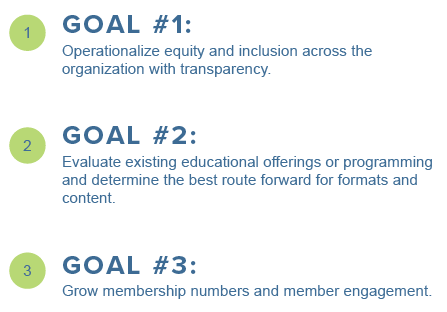- APBP
- Membership
- Chapters
- Webinars
- Resources
- News
- Events
About APBPAPBP is a community of practitioners working to create more walkable, bikeable places. We foster peer knowledge sharing, advance technical expertise, and support the professional development of our members who work in government, consulting firms, and in non-profit organizations in the fields of transportation planning and engineering, urban design and planning, public health and active living. In November 2021, APBP's leadership went through a Strategic Planning process. View our 2022-2024 Strategic Plan Report to learn more about our goals to:
APBP's History APBP was founded before the Internet became widely used. Its initial membership comprised a few dozen state and local bicycle and pedestrian coordinators, consultants and advocates. APBP’s first list serve was developed by a professor and an IT staffer at Indiana State University through APBP’s e-mail address at the university. This information exchange blossomed into a formal organization with paying members in 1995, hosted initially by the Bicycle Federation of America (BFA; later the National Center for Biking and Walking). At an organizing meeting in Washington, D.C., Barbara McMillan of the Federal Highway Administration, Andy Clarke and Charlie Gandy of BFA, and Jeff Olson from New York State DOT sketched out the acronym "APBP.” The association’s Articles of Incorporation, filed July 2, 1998, were signed by Mia Birk, Dan Burden, Andy Clarke, Ben Gomberg, Ann Gordon, Barbara McMillen, Phil Miller, Tim Oliver, Jeff Olson, Arthur Ross, Dennis Scott, Rick Waring and Craig Williams. The first executive director, Andy Clarke, was hired in 1999 and served until 2003. After Andy’s departure, an association management company took over responsibilities for APBP’s day-to-day operation. In 2006, the Board determined the need for a dedicated professional to serve as Executive Director. Kit Keller, an attorney and public policy consultant with a passion for bicycling and walking, was hired and continued in this role until 2016. Her work was supported by part-time staff and consultants. From a handful of members in 1994, the organization has grown to include 1,200 members in the United States and Canada. APBP members work at all levels of government, in manufacturing, and as consultants, advocates, researchers, and students in a wide range of disciplines: transportation planning and engineering, urban design, landscape architecture, public health, active living, and Safe Routes to School. APBP offers technical training and resources to build capacity for sustainable transportation, including a monthly webinar series, the biennial Professional Development Seminar, Complete Streets and pedestrian accessibility workshops, and the respected Bicycle Parking Guidelines, 2nd Edition. In 2016, as Kit Keller looked to move on to new opportunities, she led the charge to research an Association Management Company (AMC) to take over the staffing, managerial and administrative functions for APBP. AMR was chosen and still serves as the management company for the association today with an Executive Director, Program Manager, and multiple shared services departments continuously working behind the scenes.
|

